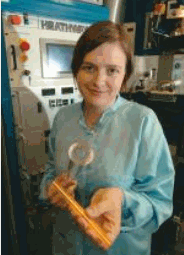|
|
|
|
|
|
|
News & Views item - October 2008 |
![]() Prime Minister Awards 2008 Prize for Science to Queensland’s Professor Ian
Frazer. (October 17, 2008)
Prime Minister Awards 2008 Prize for Science to Queensland’s Professor Ian
Frazer. (October 17, 2008)
Yesterday evening the 2008 Prime Minister's and Science Minister's Science prizes were awarded at the Great Hall, Parliament House in Canberra.
In summary:
Prime Minister’s Prize for Science: Professor
Ian Frazer, Diamantina Institute for Cancer Immunology & Metabolic Medicine,
Queensland
Former Director of the Walter and Eliza Hall Institute of Medical Research Sir Gustav Nossal commenting on the award to Professor Frazer said: "It is an enormous thrill to hear that [he] has won. His achievement is a monumental one – a vaccine against the dreaded human papilloma virus (HPV)
 |
|
Professor Tanya Monro |
which is the cause of cervical cancer in women. This vaccine has been brilliantly successful and the rollout in Australia has really led the world in terms of both uptake and freedom from any significant side effects. Frazer is currently working very hard to get this vaccine into the developing countries where the need is greatest. Over a quarter of a million women die each year from cervical cancer and most of these are in developing countries. The award to Frazer will be universally welcome right around Australia and around the world."
Commenting on the Prime Minister's prizes for science teaching to Bronwyn Mart and Clay Reid, Peter Russo, CEO of the Australian Science Teachers Association pointed out the requirement for "dedication and commitment to the science teaching profession to make a real difference to the lives of students and said: "Both of these excellent teachers, through their work in the classroom and in the wider community, have highlighted the importance of nurturing curiosity in children as a key driver of engaging young learners in science and possibly into pursuing a rewarding career in the field. This leadership in creative and innovative learning is crucial to the well-being of our nation."
Professor Tanya Monro received
the
Dr Carola Vinuesa was named winner of the Science Minister's Prize for Life Scientist of the Year. Dr Vinuesa and her team working at ANU's John Curtin School of Medical Research uncovered a non-structural gene in mice they named Roquin which regulates the function of microRNAs previously dismissed as the products of junk DNA but which in fact affected lupus diabetes -like symptoms when Roquin mutated.
Dr Vinuesa believes that more effort should be exerted in gaining fuller understanding of the functioning of micro-RNAs.
________________________________
To learn more about the recipients and listen to them talk about what drives them click here then when the web page comes up click on the individual's link.